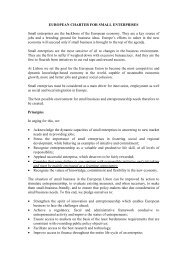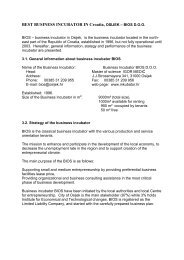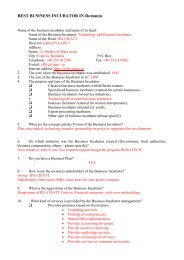After creation <strong>and</strong> starting implementation <strong>of</strong> <strong>SME</strong> government support concept <strong>and</strong>program <strong>SME</strong> development process became efficient <strong>and</strong> successful. After studying <strong>the</strong>experience <strong>of</strong> <strong>SME</strong> development particularly in <strong>the</strong> countries in transition, taking intoconsideration recommendations <strong>of</strong> international organizations <strong>and</strong> proposals <strong>of</strong> <strong>SME</strong> supportNGOs, <strong>SME</strong> support general ways, forms <strong>and</strong> mechanisms have been identified. In this concern<strong>the</strong> C<strong>SME</strong>DA jointly with <strong>the</strong> Ministry <strong>of</strong> Economy, Industry <strong>and</strong> Trade worked out “<strong>SME</strong> StateSupport Program for 2002-2004” approved by <strong>the</strong> President Decree No. 309 as <strong>of</strong> 22 June2002.The program determines <strong>the</strong> main ways <strong>of</strong> <strong>SME</strong> promotion <strong>and</strong> government supportmeasures. For its effective implementation <strong>the</strong> following issues have been determined:- Create simple tax regime for <strong>SME</strong>s in united taxation system;- Simplify account <strong>and</strong> report system for <strong>SME</strong>s;- Simplify company registration procedure <strong>and</strong> make it cheap decreasing registration fees,separate court <strong>and</strong> notary service functions etc;- Implement simple license system for separate entrepreneurial activities;- Make in order activity <strong>of</strong> control, supervisory <strong>and</strong> legal institutions concerning to <strong>SME</strong>.Coordinate activity <strong>of</strong> above-mentioned institutions to optimize state control on <strong>SME</strong>. Itis necessary to create database that should consist <strong>of</strong> clear <strong>and</strong> transparent informationabout work done, breaches, penalty sanctions <strong>and</strong> future check schedule as well.- Financial support for attracting investment: that means to provide more favourableloans to small entrepreneurs <strong>and</strong> start-ups than commercial banks. Also provideguarantee for commercial bank loans <strong>and</strong> subsidize commercial bank loan interest rate;- Relevant to funding create infrastructure such as business incubators, information <strong>and</strong>advisory centres, leasing companies <strong>and</strong> etc.;- In order to making active <strong>SME</strong> participation in getting <strong>and</strong> doing state orders createrelevant mechanism;- Actively monitor <strong>the</strong> implementation <strong>of</strong> <strong>SME</strong> state support measures;- Provide funding for <strong>SME</strong> state support program.Over <strong>the</strong> last years <strong>the</strong> number <strong>of</strong> registered legal entities have been increased <strong>and</strong> thistendency is continuing, which points on society high entrepreneurial activity. Total number <strong>of</strong>enterprises is 84,239 at <strong>the</strong> beginning <strong>of</strong> 2003, among <strong>the</strong>m 15,218 enterprises are registeredin 2002, more than 10,649 units - in 2001 <strong>and</strong> 7,294 – in 2000. Individual enterprises are <strong>the</strong>main part <strong>of</strong> entrepreneurial activity. Their number has been increased from 29,152 to 49,952(171.4%) in 2000-2002. This is <strong>the</strong> result <strong>of</strong> simplification <strong>of</strong> registration <strong>and</strong> account-reportingprocedures for individual enterprises.It should be emphasized that <strong>the</strong> number <strong>of</strong> individual enterprises are 60% <strong>of</strong> totalnumber <strong>of</strong> any legal entities, <strong>and</strong> 99.9% <strong>of</strong> individual companies is considered smallenterprises. This situation shows that <strong>SME</strong>s are <strong>the</strong> main factors <strong>of</strong> entrepreneurial activities in<strong>the</strong> country.According to surveys <strong>the</strong> number <strong>and</strong> quality <strong>of</strong> <strong>SME</strong>s have been improved in Georgia.In particular, <strong>the</strong> share <strong>of</strong> <strong>SME</strong>s in <strong>the</strong> total number <strong>of</strong> active enterprises is permanentlygrowing. At <strong>the</strong> beginning <strong>of</strong> 2003 small enterprises’ share was 90.0%, medium enterprises –7.4% in total active enterprises. <strong>SME</strong> generates half <strong>of</strong> total employment in entrepreneurialsector <strong>and</strong> 20% <strong>of</strong> ready-made product.In creation <strong>of</strong> business environment <strong>SME</strong> is relevantly developed but <strong>the</strong> country is stillfar from <strong>the</strong> level <strong>of</strong> developed countries.The contribution to GDP by <strong>SME</strong>s is very low • only10%, compared to 40% in many CIS countries <strong>and</strong> more than 60% in a number <strong>of</strong> EuropeanUnion countries. There are not even any proper statistics for <strong>the</strong> <strong>SME</strong> market. It is an estimate,that nearly 60% <strong>of</strong> businesses operating in Georgia aren’t registered at all. Statistics can be112
obtained only different sources. Businesses only register <strong>the</strong>mselves when <strong>the</strong>y go to banks toget credit,” Sutiashvili says.Definition <strong>of</strong> Small, Medium, <strong>and</strong> Large Enterprise in GeorgiaIn Georgian legislation, small, medium, <strong>and</strong> large enterprises are defined as follows:• Small enterprise - average number <strong>of</strong> employees does not exceed 20 <strong>and</strong> sales do notexceed GEL 500,000 per annum;• Medium enterprise - average number <strong>of</strong> employees does not exceed 100 <strong>and</strong> sales donot exceed GEL 1,500,000 per annum; <strong>and</strong>• Large enterprise - average number <strong>of</strong> employees exceeds 100 <strong>and</strong> sales exceed GEL1,500,000 per annum.There are two criteria for determining <strong>the</strong> size category <strong>of</strong> a company: <strong>the</strong> number <strong>of</strong>employees <strong>and</strong> annual turnover. For example, a company with four employees but with annualsales <strong>of</strong> GEL 2,000,000 is categorized as a large enterprise. A company with 80 employees butwith annual sales <strong>of</strong> GEL 1,000,000 is considered a medium enterprise.Meanwhile, <strong>SME</strong> sector couldn’t achieve <strong>the</strong> desirable level because <strong>of</strong> some generalmacro -economic <strong>and</strong> specific factors. <strong>SME</strong>s have less productivity level <strong>and</strong> capital facilitiesthan large enterprises. There is a disproportion in <strong>the</strong> sectoral <strong>and</strong> regional structures <strong>of</strong> smallentrepreneurship. Leading fields <strong>of</strong> <strong>SME</strong>s are trade <strong>and</strong> service (more than 70%), but for <strong>the</strong>last years <strong>the</strong> number <strong>of</strong> small enterprises has temporary been increased in processingindustry, construction, transport <strong>and</strong> communication. Small enterprises are mostlyconcentrated in <strong>the</strong> capital, Tbilisi. This situation is relevant to <strong>the</strong> countries in transition. Insome industrial regions (Adjara A/R, Imereti, Kvemo Kartli etc) favourable conditions arecreated for development <strong>of</strong> small entrepreneurship vice versa in high l<strong>and</strong> regions (Tsalka,Samtskhe-Javakheti, Mtskheta-Mtianeti, Racha-Lechkhumi, Svaneti). That’s whyimplementation <strong>of</strong> priority support measures in high l<strong>and</strong> regions is an argent issue.It should be emphasized an inadequate growing <strong>of</strong> <strong>SME</strong> quality relevant to <strong>SME</strong> number.But <strong>the</strong> tendency points on increasing role <strong>of</strong> <strong>SME</strong> in creation <strong>of</strong> a new economy. In particular,small enterprises already produce more than 20% <strong>of</strong> GDP <strong>and</strong> almost one fifth <strong>of</strong> <strong>the</strong> addedvalue. Small entrepreneurship covers one third <strong>of</strong> total entrepreneurial employment.113
- Page 4 and 5:
1. SME DECLARATION AND WORKING GROU
- Page 6 and 7:
While comparing the BSEC and EU doc
- Page 8 and 9:
cooperation with the United Nations
- Page 10 and 11:
GENERAL ASSESSMENT OF THE BSEC WG O
- Page 12 and 13:
“Armenia's new law introduces a n
- Page 14 and 15:
(iii)Share of the labor force of SM
- Page 16 and 17:
The following data represents some
- Page 18 and 19:
RankDocuments for export(number)Tra
- Page 20 and 21:
• Industrial zones/Business incub
- Page 22 and 23:
3.1.4. FINANCING SMEsProf. Dr. Sela
- Page 24 and 25:
• the loan is secured with movabl
- Page 26 and 27:
3.1.4.3. Mutual and loan guarantee
- Page 28 and 29:
introduction of e-signatures, only
- Page 30 and 31:
The Code of Conduct for Civil Serva
- Page 32 and 33:
Trading Across Borders Enforcing Co
- Page 34 and 35:
as with all non-governmental organi
- Page 36 and 37:
Bulgarian SMEs obtain additional ca
- Page 38 and 39:
• Project BG 2004/016-711.11.04 -
- Page 40 and 41:
usiness is not approaching them oft
- Page 42 and 43:
• Romanian citizens are recognize
- Page 44 and 45:
The preparatory project of the NDP
- Page 46 and 47:
• To support participation in eco
- Page 48 and 49:
In 2004, the National Institute of
- Page 50 and 51:
Incubators host on average 11 SME,
- Page 52 and 53:
Programs. The program is implemente
- Page 54 and 55:
development instrument is extremely
- Page 56 and 57:
accounting standards, including med
- Page 58 and 59:
corporations and open held corporat
- Page 60 and 61:
promoting SME sector, cooperation w
- Page 62 and 63: • for unemployed (micro credit)
- Page 64 and 65: are private pension funds, broker h
- Page 66 and 67: very early steps of its democratic
- Page 68 and 69: Another negative factor that is mor
- Page 70 and 71: economy. The so called in the organ
- Page 72 and 73: Federal funds, private capital, esp
- Page 74 and 75: 4.3. MOLDOVATable 14.Dimensions Neg
- Page 76 and 77: Related andsupportingindustriesDome
- Page 78 and 79: Technological:Internetaccessibility
- Page 80 and 81: Domesticdemand• Still not many pe
- Page 82 and 83: international investments• Govern
- Page 84 and 85: 3. Hamel, G., Prahalad, C.K. (1994)
- Page 86 and 87: 5.2 DEVELOPMENT OF THE SME SECTOR I
- Page 88 and 89: General Characteristic of SME Devel
- Page 90 and 91: Index of SME Development in Armenia
- Page 92 and 93: The same problem exists in getting
- Page 94 and 95: SME support infrastructure in Armen
- Page 96 and 97: 5 million was provided by UNDP and
- Page 98 and 99: 5.3 DEVELOPMENT OF THE SME SECTOR I
- Page 100 and 101: Diagram 1. The number of small ente
- Page 102 and 103: The privatization process of object
- Page 104 and 105: 13.Cabinet Provision on “Distribu
- Page 106 and 107: 5.3.3. SME support infrastructure i
- Page 108 and 109: The role of the state in technical
- Page 110 and 111: General situation of credit marketT
- Page 114 and 115: At the meantime, small enterprise s
- Page 116 and 117: Table. 32.Ease of businessDoingBusi
- Page 118 and 119: people who start small businesses t
- Page 120 and 121: are salaried and the medium - sized
- Page 122 and 123: Technology Foresight in Greece 2001
- Page 124 and 125: Greek VC market started to develop
- Page 126 and 127: In the area of bankruptcy and restr
- Page 128 and 129: enterprises. According to TURKSTAT,
- Page 130 and 131: small size enterprise or micro ente
- Page 132 and 133: industrial enterprises. Undersecret
- Page 134 and 135: individuals, rather than well struc
- Page 136 and 137: 7. SUGGESTIONS FOR THE SME DEVELOPM
- Page 138 and 139: Annex 1.MAP OF THE BLACK SEA COUNTR
- Page 140 and 141: 17-18 June 2005 1 st Moscow Interna
- Page 142 and 143: ARMENIASTRENGTHS• Application of
- Page 144 and 145: BULGARIASTRENGHT• Flexibility and
- Page 146 and 147: GREECESTRENGHT• They have a vital
- Page 148 and 149: ROMANIASTRENGHTWEAKNESS• Stabilis
- Page 150 and 151: REPUBLIC OF SERBIASTRENGHT• Longe
- Page 152 and 153: UKRAINESTRENGTHS• Well educated l
- Page 154 and 155: In compliance with the Resolution m
- Page 156 and 157: 1. Please provide definition of SME
- Page 158 and 159: 7. Did you establish a dedicated bo
- Page 160: 11. Do you have any suggestions for
















